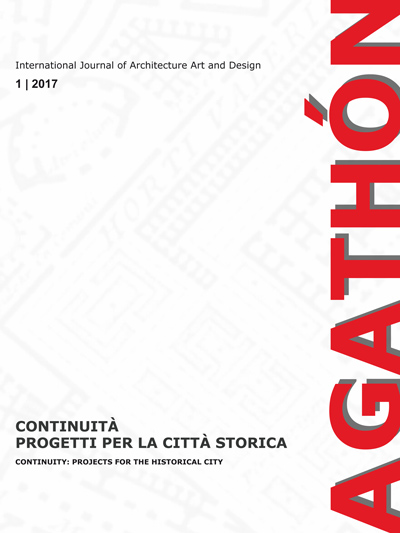
AGATHÓN
International Journal
of Architecture, Art and Design
ISSN (online) 2532-683X
ISSN (print) 2464-9309
V. 1 (2017): CONTINUITÀ: PROGETTI PER LA CITTÀ STORICA

Dalla crisi degli anni Settanta agli anni ’90, oltre a una politica mirata al recupero del patrimonio edilizio moderno e contemporaneo, è stato possibile rilevare sia una più ampia ricerca sui beni culturali del nostro Paese, sia un crescente interesse del pubblico verso i contesti antichi. Con il termine Contesti Antichi ci si riferiva a quegli insiemi architettonici e ambientali a forte connotazione storica, che risultano stratificati da antica data, spesso sovrapposti, e che occupano ambiti extra-urbani e urbani. Tali siti sono luoghi in cui è necessario il confronto disciplinare fra l’archeologia, la storia dell’arte, l’architettura, la museografia, l’urbanistica, l’ingegneria naturalistica e, non ultima, la tecnologia; ciò non soltanto per la loro conoscenza, ma anche per la conservazione, la messa in valore e la loro fruizione.
Per stimolare su tale tema particolare un confronto tra diverse aree disciplinari, AGATHÓN raccoglie i contributi di studiosi con l'obiettivo di: a) contribuire, con analisi legate ai processi formativi, alla conoscenza, complessa e pluridisciplinare, che i contesti antichi richiedono per il recupero, la conservazione e la fruizione; b) integrare la cultura umanistica con la cultura scientifica, tecnologica e ambientale; c) determinare criteri, parametri e stime per una conservazione duratura e adeguata, sia al degrado che al contesto specifico; c) mirare alla messa in valore e alla fruizione di tali contesti antichi, ricercandone le implicazioni museografiche ed economiche.
Ciascun numero della Rivista accoglie lavori di ricerca su di un tema specifico, lavori non pubblicati, né proposti per la pubblicazione ad altro editore, su temi riguardanti l’architettura, l’arte, il design. I contributi saranno pubblicati in lingua italiana e inglese, così da poter essere collocati nel più vasto contesto di ricerca internazionale. Principi fondanti della Rivista sono l’originalità e la rilevanza dei contributi, il rigore della metodologia, ma anche l’agevole accessibilità e l’ampia diffusione degli articoli. Un adeguato spazio, nella misura di circa il 40%, è affidato alle immagini. L’umanista Giovanni Aurelio Augurelli, in un carme latino scritto nelle seconda metà del ‘400, così diceva sulle immagini: «multi multa ferunt, eadem sententia nulli est / pulchrius est pictis istud imaginibus», cioè molti propongono molte interpretazioni, nessuno è dello stesso parere; tutto questo è più bello delle stesse immagini, dipinti o fotografie che siano. In altri termini il bello delle immagini sta nel fatto che esse ci spingono a cercare significati, a ricordare e ad attivare l’immaginazione, con risultato molteplici.













































































